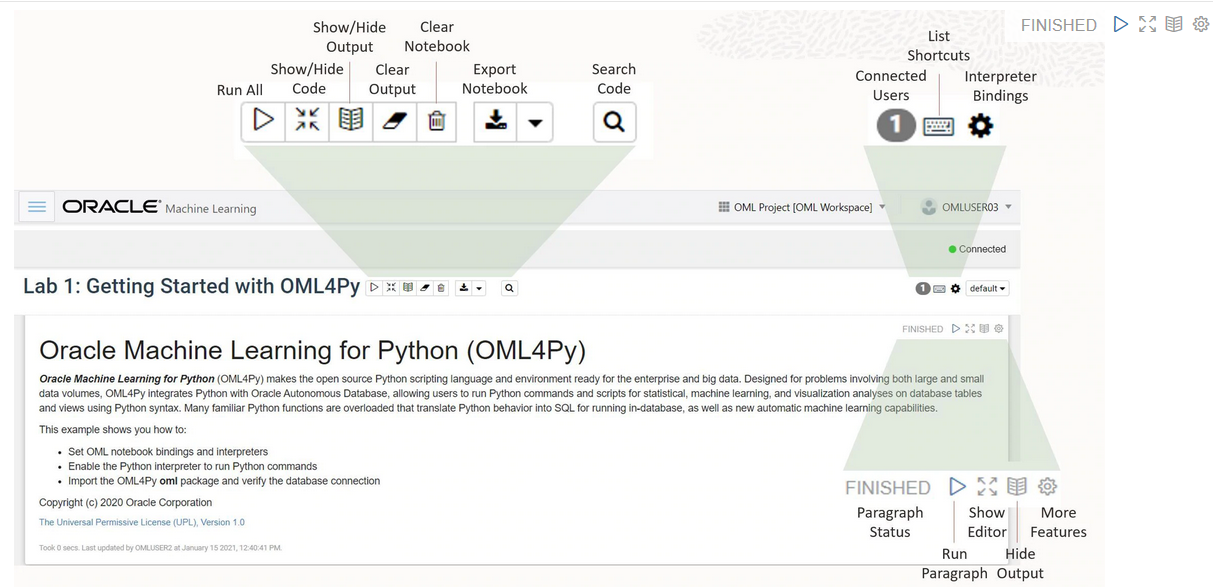Access OML Notebooks
To perform Oracle Machine Learning tasks, you can access Oracle Machine Learning Notebooks from Autonomous Database
Access Oracle Machine Learning Notebooks
You can access Oracle Machine Learning Notebooks from Autonomous Database.
To access Oracle Machine Learning Notebooks from the Autonomous Database:
- Select your Autonomous Database instance and on the Autonomous Database details page click Database Actions.

- On the Database Actions page, go to the Development section and click Oracle Machine Learning. The Oracle Machine Learning sign in page opens.

- On the Oracle Machine Learning sign in page, enter your username and password.
- Click Sign In.
This opens the Oracle Machine Learning user application.
Create a Notebook
A notebook is a web-based interface for data analysis, data discovery, data visualization and collaboration.
Whenever you create a notebook, it has an interpreter settings specification. The notebook contains an internal list of bindings that determines the order of the interpreter bindings. A notebook comprises paragraphs which is a notebook component where you can write SQL statements, run PL/SQL scripts, and run Python commands. A paragraph has an input section and an output section. In the input section, specify the interpreter to run along with the text. This information is sent to the interpreter to be executed. In the output section, the results of the interpreter are provided.
To create a notebook:
Your notebook is created and it opens in the notebook editor. You can now use it to run SQL statements, run PL/SQL scripts, and run Python commands. To do so, specify any one of the following directives in the input section of the paragraph:
%sql- To call the SQL interpreter and run SQL statements%script- To call PL/SQL interpreter and run PL/SQL scripts%md- To call the Markdown interpreter and generate static html from Markdown plain text%python- To call the Python interpreter run Python scripts
Edit Your Notebook
Upon creating a notebook, it opens automatically, presenting you with a single paragraph using the default %sql interpreter. You can change the interpreter by explicitly specifying one of %script, %python, %sql or %md
Set the context with a project with which your notebook is associated.
You can edit an existing notebook in your project. To edit an existing notebook:

 to run one or all paragraphs in the notebook.
to run one or all paragraphs in the notebook.
 to hide all codes from all the paragraphs in the notebook. Click it again to display the codes.
to hide all codes from all the paragraphs in the notebook. Click it again to display the codes.
 to hide all outputs from all the paragraphs in the notebook. Click it again to view the outputs.
to hide all outputs from all the paragraphs in the notebook. Click it again to view the outputs.
 to remove all outputs from all the paragraphs in the notebook. To view the output, click the run icon again.
to remove all outputs from all the paragraphs in the notebook. To view the output, click the run icon again.
 to delete all the paragraphs in the notebook.
to delete all the paragraphs in the notebook.
 to export the notebook.
to export the notebook.
 to search any information in the codes present in the notebook.
to search any information in the codes present in the notebook.
 to view the list of keyboard shortcuts.
to view the list of keyboard shortcuts.
 to set the order for interpreter bindings for the notebook.
to set the order for interpreter bindings for the notebook.
 to select one of the three notebook display options.
to select one of the three notebook display options.
 to access paragraph specific edit options such as clear output, remove paragraph, adjust width, font size, run all paragraphs above or below the selected paragraph and so on.
to access paragraph specific edit options such as clear output, remove paragraph, adjust width, font size, run all paragraphs above or below the selected paragraph and so on.